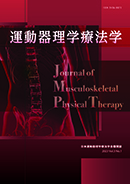Volume 3, Issue 1
Displaying 1-5 of 5 articles from this issue
- |<
- <
- 1
- >
- >|
-
2023 Volume 3 Issue 1 Pages 1-6
Published: 2023
Released on J-STAGE: September 30, 2023
Advance online publication: April 08, 2023Download PDF (898K) -
2023 Volume 3 Issue 1 Pages 7-13
Published: 2023
Released on J-STAGE: September 30, 2023
Advance online publication: June 12, 2023Download PDF (1444K) -
2023 Volume 3 Issue 1 Pages 14-20
Published: 2023
Released on J-STAGE: September 30, 2023
Advance online publication: June 12, 2023Download PDF (1171K) -
2023 Volume 3 Issue 1 Pages 21-26
Published: 2023
Released on J-STAGE: September 30, 2023
Advance online publication: August 03, 2023Download PDF (2131K)
-
2023 Volume 3 Issue 1 Pages 27-40
Published: 2023
Released on J-STAGE: September 30, 2023
Advance online publication: June 28, 2023Download PDF (901K)
- |<
- <
- 1
- >
- >|
